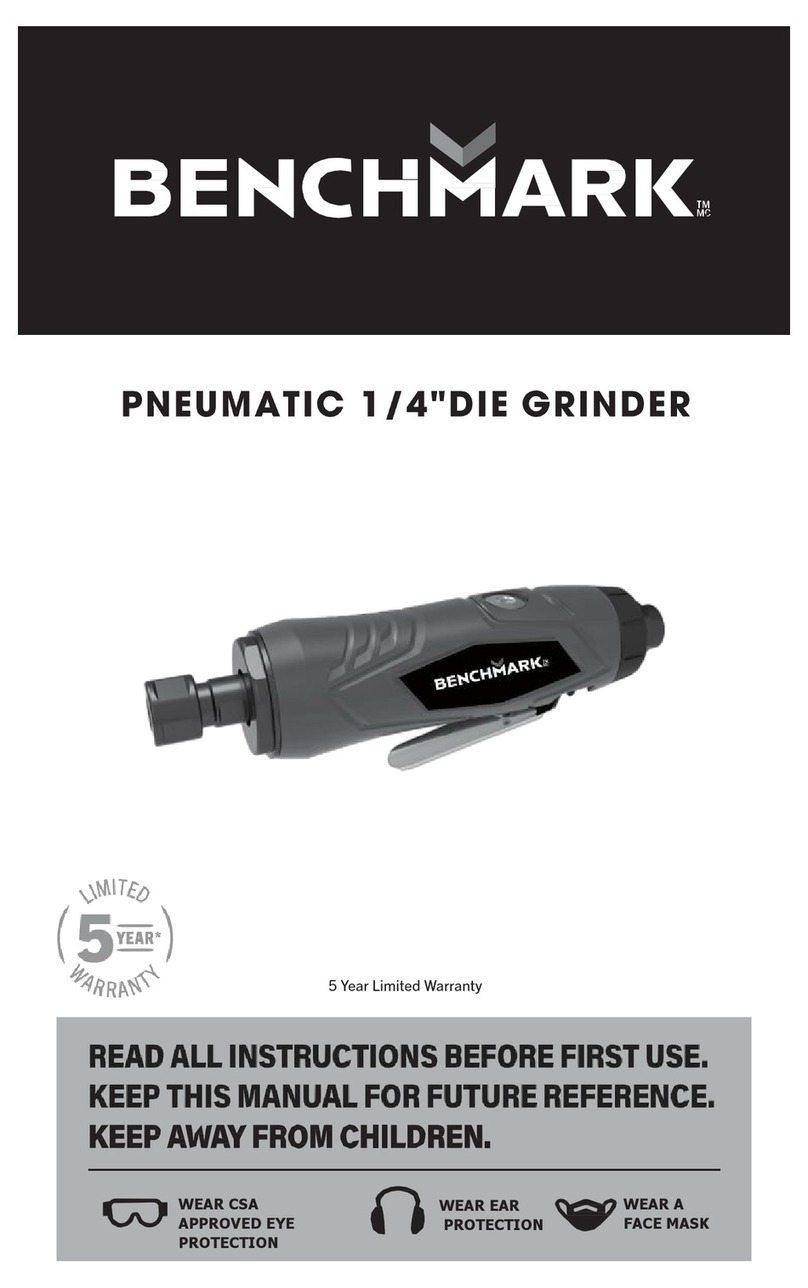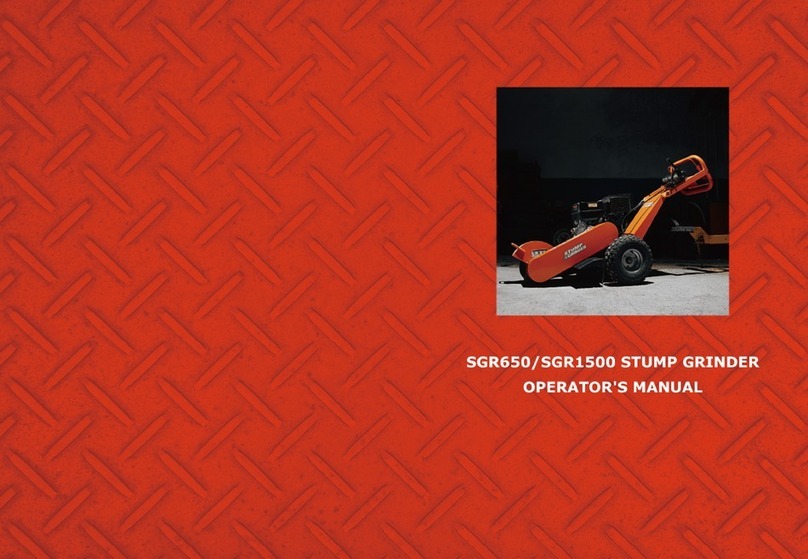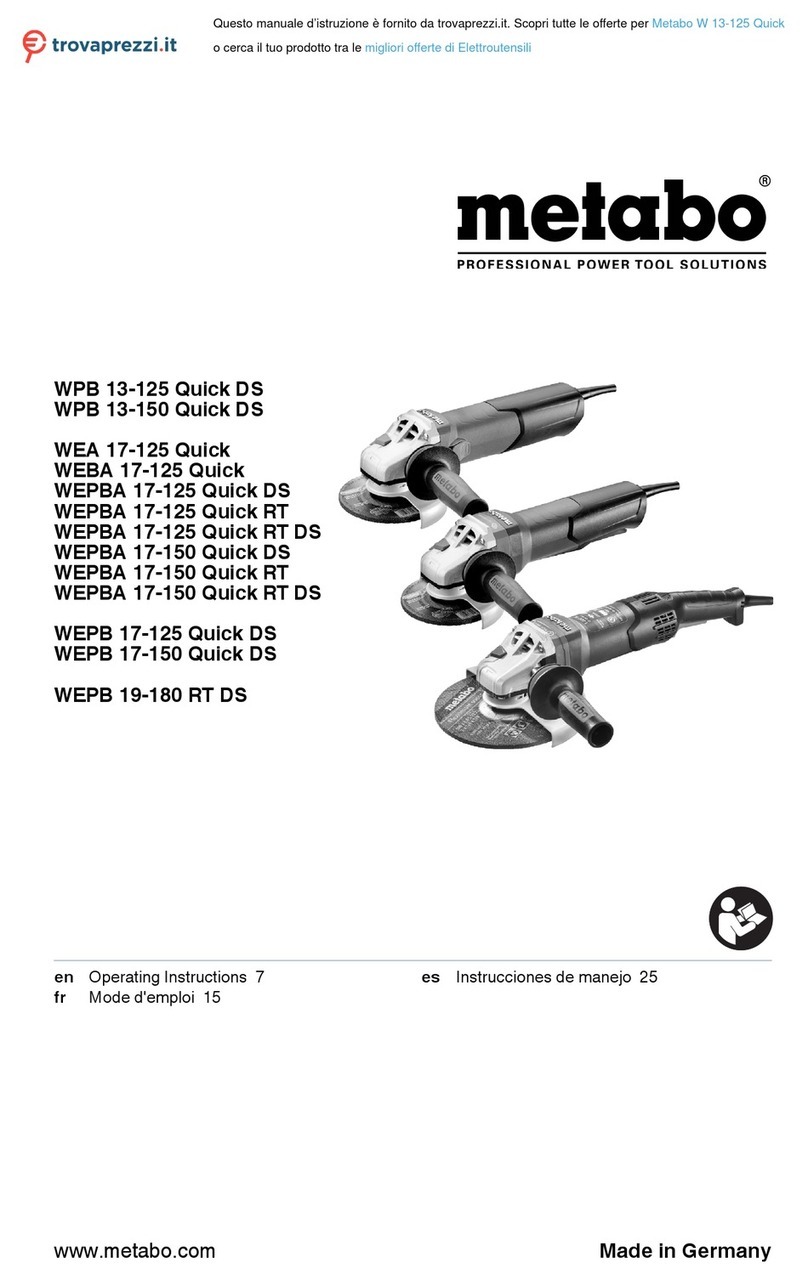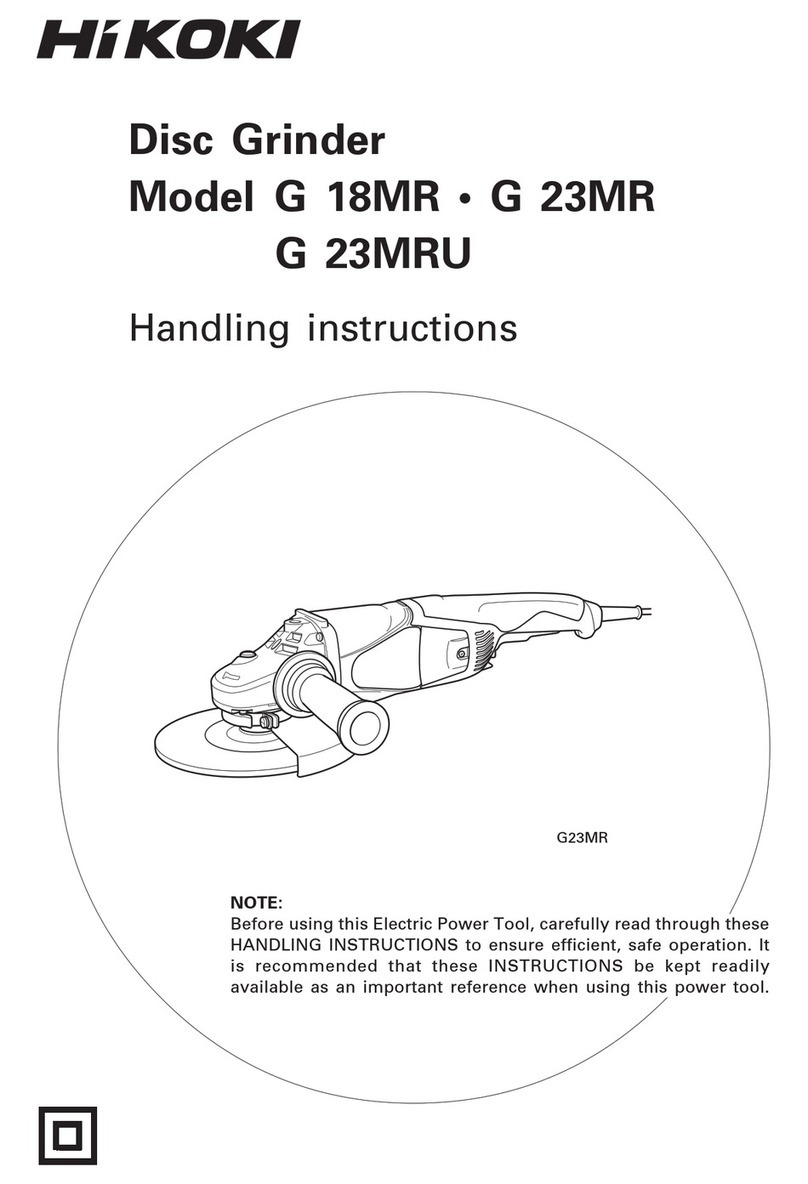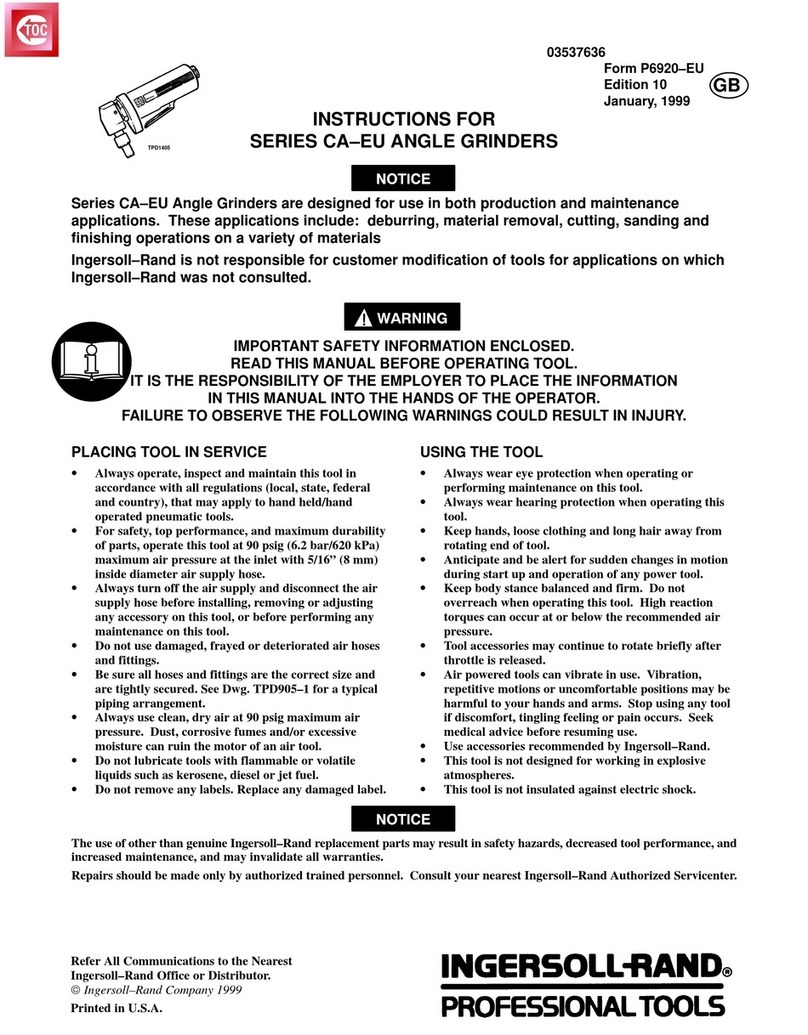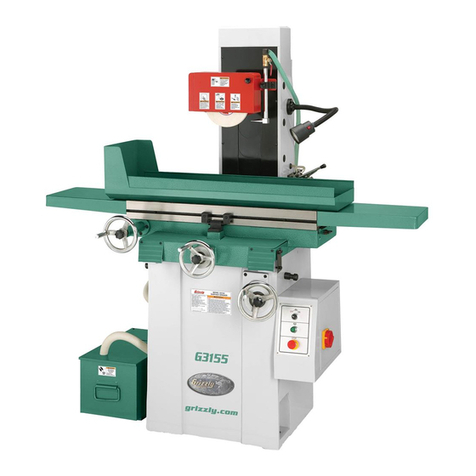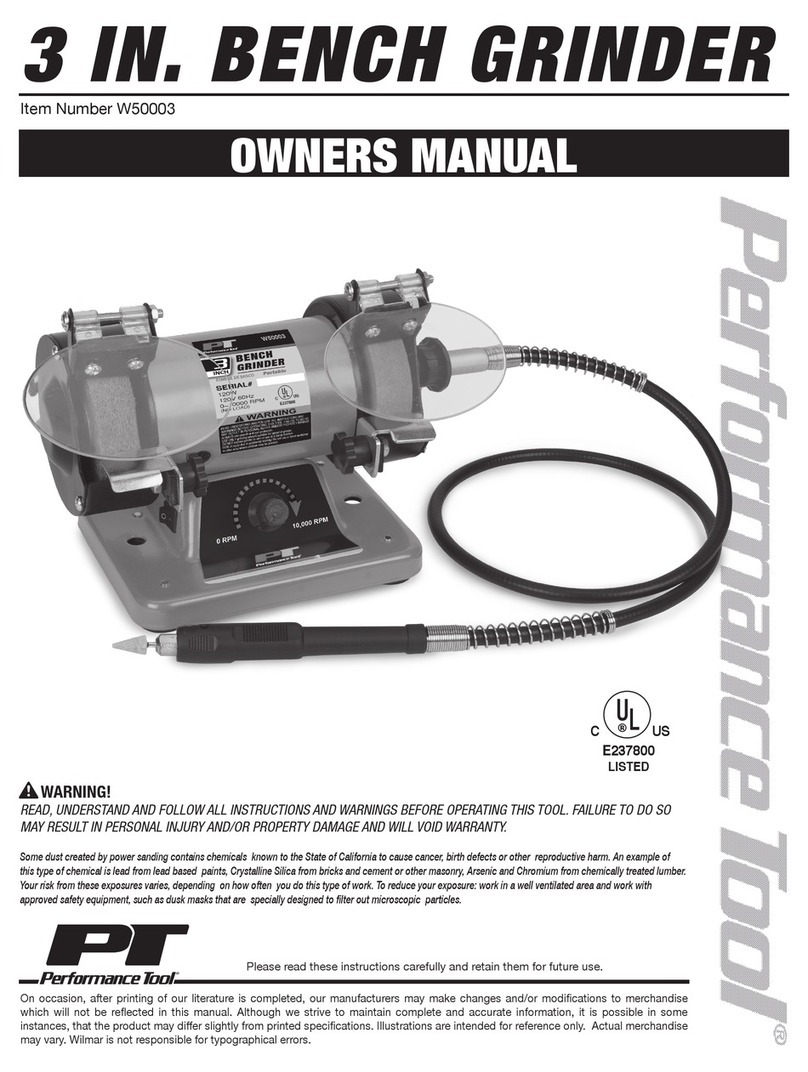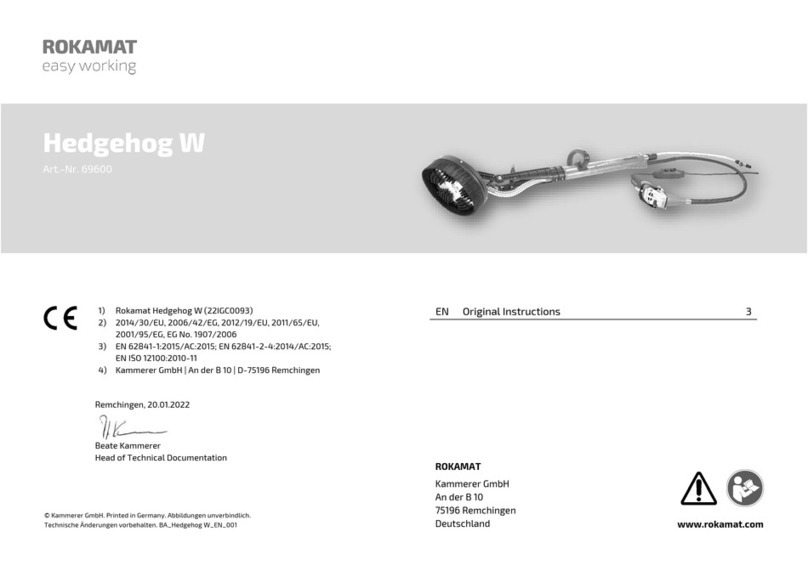Benchmark 1250-000 User manual

4-1/2" ANGLE GRINDER
3042597
JD3116U
WEAR CSA APPROVED
EYE PROTECTION
WEAR EAR
PROTECTION
WEAR A
FACE MASK
*5 year limited warranty on tool

1
PRODUCT SPECIFICATIONS
BENCHMARK 4-1/2" ANGLE GRINDER
Rating: 120V, 60Hz, AC
Amperes: 10 Amp
Ratring speed: 11800 RPM (no load)
Arbor size: 5/8"
Blade size 4-1/2"
Weight: 10 lbs / 4.54kg
NEED ASSISTANCE?
Call us on our toll-free customer support line:
1-866-349-8665 (Monday through Friday 9am – 5pm Eastern Standard Time)
• Technical questions
• Replacement parts
• Parts missing from package

1250-000
4-1/2" ANGLE GRINDER
2
TABLE OF CONTENTS
Product Specifications .................................................................................. 1
Table of Contents .......................................................................................... 2
General Safety Warnings ............................................................................... 3
Power Tool Safety ....................................................................................... 4-5
Specific Safety Rules for Angler Grinders .................................................... 6-9
Extension Cord Safety .............................................................................. 9-10
Symbols ...................................................................................................... 11
Know Your Angler Grinder ............................................................................ 12
Assembly and Operating ........................................................................ 12-17
Maintenance .......................................................................................... 18-20
Exploded View ............................................................................................ 21
Parts List ............................................................................................... 22-23
Warranty ..................................................................................................... 24

3
GENERAL SAFETY WARNINGS
WARNING:
Before using this tool or any of its accessories, read this manual and follow all Safety
Rules and Operating Instructions. The important precautions, safeguards and
instructions appearing in this manual are not meant to cover all possible situations.
It must be understood that common sense and caution are factors which cannot be
built into the product.
EYE, EAR & LUNG PROTECTION
ALWAYS WEAR EYE PROTECTION THAT CONFORMS WITH CSA
REQUIREMENTS or ANSI SAFETY STANDARD Z87.1
FLYING DEBRIS can cause permanent eye damage. Prescription eyeglasses ARE NOT
a replacement for proper eye protection.
WARNING:
Non-compliant eyewear can cause serious injury if broken during the operation of a
power tool.
WARNING:
Use hearing protection, particularly during extended periods of operation of the
tool, or if the operation is noisy.
WEAR A DUST MASK THAT IS DESIGNED TO BE USED WHEN
OPERATING A POWER TOOL IN A DUSTY ENVIRONMENT.
WARNING:
Dust that is created by power sanding, sawing, grinding, drilling, and other
construction activities may contain chemicals that are known to cause cancer, birth
defects, or other genetic abnormalities. These chemicals include:
• Lead from lead-based paints
• Crystalline silica from bricks, cement, and other masonry products
• Arsenic and chromium from chemically treated lumber
The level of risk from exposure to these chemicals varies according to how often this
type of work is performed. In order to reduce exposure to these chemicals, work in a
well-ventilated area, and use approved safety equipment, such as a dust mask that
is specifically designed to filter out microscopic particles.
ELECTRICAL SAFETY
WARNING:
To avoid electrical hazards, fire hazards or damage to the tool, use proper circuit
protection.
This tool is wired at the factory for 120V AC operation. It must be connected to a
120V AC, 15 A circuit that is protected by a time-delayed fuse or circuit breaker. To
avoid shock or fire, replace power cord immediately if it is worn, cut or damaged in
any way.

1250-000
4-1/2" ANGLE GRINDER
4
POWER TOOL SAFETY
WARNING:
Read all safety warnings and instructions. Failure to follow the warnings and
instructions may result in electric shock, fire and/or serious injury.
SAVE ALL WARNINGS AND INSTRUCTIONS FOR FUTURE REFERENCE.
WORK AREA SAFETY
Keep work area clean and well lit. Cluttered or dark areas invite accidents.
Do not operate power tools in explosive atmospheres, such as in the presence of
flammable liquids, gases or dust. Power tools create sparks which may ignite the
dust or fumes.
Keep children and bystanders away while operating a power tool. Distractions can
cause you to lose control.
ELECTRICAL SAFETY
Power tool plugs must match the outlet. Never modify the plug in any way. Do not
use any adapter plugs with earthed (grounded) power tools. Unmodified plugs and
matching outlets will reduce risk of electric shock.
Avoid body contact with earthed or grounded surfaces such as pipes, radiators,
ranges and refrigerators. There is an increased risk of electric shock if your body is
earthed or grounded.
Do not expose power tools to rain or wet conditions. Water entering a power tool will
increase the risk of electric shock.
Do not abuse the cord. Never use the cord for carrying, pulling or unplugging the
power tool. Keep cord away from heat, oil, sharp edges or moving parts. Damaged or
entangled cords increase the risk of electric shock.
When operating a power tool outdoors, use an extension cord suitable for outdoor
use. Use of a cord suitable for outdoor use reduces the risk of electric shock.
If operating a power tool in a damp location is unavoidable, use a residual current
device (RCD) protected supply. Use of a ground fault circuit interrupter (GFCI)
reduces the risk of electric shock.
PERSONAL SAFETY
Stay alert, watch what you are doing and use common sense when operating a
power tool. Do not use a power tool while you are tired or under the influence of
drugs, alcohol or medication. A moment of inattention while operating power tools
may result in serious personal injury.
Use personal protective equipment. Always wear eye protection. Protective
equipment such as dust mask, non-skid safety shoes, hard hat, or hearing
protection used for appropriate conditions will reduce personal injuries.
Prevent unintentional starting. Ensure the switch is in the OFF position before
connecting to power source and/or battery pack, picking up or carrying the tool.
Carrying power tools with your finger on the switch or energizing power tools that
have the switch on invites accidents.

5
Remove any adjusting key or wrench before turning the power tool on. A wrench or a
key left attached to a rotating part of the power tool may result in personal injury.
Do not overreach. Keep proper footing and balance at all times. This enables better
control of the power tool in unexpected situations.
Dress properly. Do not wear loose clothing or jewellery. Keep your hair, clothing and
gloves away from moving parts. Loose clothes, jewellery or long hair can be caught
in moving parts.
If devices are provided for dust extraction and collection, ensure these are
connected and properly used. Use of dust collection facilities can reduce dust-
related hazards.
POWER TOOL USE AND CARE
Do not force the power tool. Use the correct power tool for your application. The
correct power tool will do the job better and safer at the rate for which it was
designed.
that cannot be controlled with the switch is dangerous and must be repaired.
Disconnect the plug from the power source and/or the battery pack from the
power tool before making any adjustments, changing accessories, or storing power
tools. Such preventive safety measures reduce the risk of starting the power tool
accidentally.
Store idle power tools out of the reach of children and do not allow persons
unfamiliar with the power tool or these instructions to operate the power tool. Power
tools are dangerous in the hands of untrained users.
Maintain power tools. Check for misalignment or binding of moving parts, breakage
damaged, have the power tool repaired before use. Many accidents are caused by
poorly maintained power tools.
Keep cutting tools sharp and clean. Properly maintained cutting tools with sharp
cutting edges are less likely to bind and are easier to control.
Use the power tool, accessories and tool bits etc. in accordance with these
instructions, taking into account the working conditions and the work to be
result in a hazardous situation.
SERVICE
Have your power tool serviced by a qualified repair person using only identical
replacement parts. This will ensure that the safety of the power tool is maintained.

1250-000
4-1/2" ANGLE GRINDER
6
SPECIFIC SAFETY RULES FOR ANGLE GRINDERS
WARNING:
Know your angle grinder. Do not plug the angle grinder into the power source until
you have read and understand this Instruction Manual. Learn the tool’s applications
and limitations, as well as the specific potential hazards related to this tool.
Following this rule will reduce the risk of electric shock, fire, or serious injury.
ALWAYS WEAR EYE PROTECTION THAT CONFORMS WITH CSA
REQUIREMENTS or ANSI SAFETY STANDARD Z87.1
Everyday glasses have only impact resistant lenses. They ARE NOT safety glasses.
WARNING:
Glasses or goggles not in compliance with ANSI Z87.1 could cause serious injury
when they break.
applications, see UL Standard 60745-2-3 Pages 7, 8 and 9.
Read all safety warnings, instructions, illustrations and specifications provided with
this power tool. Failure to follow all instructions listed below may result in electric
shock, fire and/or serious injury.
Do not use accessories which are not specifically designed and recommended by
the tool manufacturer. Just because the accessory can be attached to your power
tool, does not ensure safe operation.
The rated speed of the accessory must be at least equal to the maximum speed
marked on the power tool. Accessories running faster than their RATED SPEED can
break and fly apart.
The outside diameter and the thickness of your accessory must be within the
capacity rating of your angle grinder. Incorrectly sized accessories cannot be
adequately guarded or controlled.
Always follow the instructions related to the use of blotters, correct use of flanges
and guards, and proper storage of the accessory outlined by the manufacturer of
the accessory.
The arbor size of wheels, flanges, backing pads or any other accessory must
properly fit the spindle of the angle grinder tool. Accessories with arbor holes that
do not match the mounting hardware of the angle grinder will run out of balance,
vibrate excessively and may cause loss of control.
Do not use a damaged accessory. Before each use inspect the accessory for chips
and cracks. If the angle grinder or accessory is dropped, inspect them for damage
or install an undamaged accessory. After inspecting and installing the accessory,
position yourself and bystanders away from the plane of the rotating accessory and
run the power tool at maximum no-load speed for one minute. Damaged accessories
will normally break apart during this test time.
Wear personal protective equipment. Depending on the application, use a face
shield, safety goggles or safety glasses. As appropriate, wear a dust mask, hearing
protection, gloves and workshop apron capable of stopping small abrasive or

7
workpiece fragments. The eye protection must be capable of stopping flying debris
generated by various operations. The dust mask or respirator must be capable of
filtering particles generated by your operation. Prolonged exposure to high intensity
noise may cause hearing loss.
Keep bystanders a safe distance away from the work area. Anyone entering the work
area must wear personal protective equipment. Fragments of the workpiece or of
a broken accessory may fly away and cause injury beyond the immediate area of
operation.
Hold the angle grinder tool by insulated gripping surfaces when performing an
operation where the cutting accessory may contact hidden wiring or the angle
grinder’s cord. The cutting accessory contacting a "live" wire may make exposed
metal parts of the angle grinder "live" and shock the operator.
Position the cord clear of the spinning accessory. If you lose control, the cord may
be cut or snagged and your hand or arm may be pulled into the spinning accessory.
Never lay the angle grinder down until the accessory has come to a complete stop.
The spinning accessory may grab the surface and pull the angle grinder out of your
control.
Do not run the angle grinder while carrying it at your side. Accidental contact with
the spinning accessory could snag your clothing, pulling the accessory into your
body.
Regularly clean the angle grinder’s air vents. The motor’s fan will draw the dust
inside the housing and excessive accumulation of powdered metal may cause
electrical hazards.
Do not operate the angle grinder near flammable materials. Sparks could ignite
these materials.
Do not use accessories that require liquid coolants. Using water or other liquid
coolants may result in electrocution or shock.
KICKBACK AND RELATED WARNINGS
Kickback is a sudden reaction to a pinched or snagged rotating wheel, backing
pad, brush or any other accessory. Pinching or snagging causes rapid stalling of the
rotating accessory which in turn causes the uncontrolled angle grinder to be forced
in the direction opposite of the accessory’s rotation at the point of the binding.
For example, if an abrasive wheel is snagged or pinched by the workpiece, the edge
of the wheel that is entering into the pinch point can dig into the surface of the
material causing the wheel to climb out or kick out.
The wheel may either jump toward or away from the operator, depending on
direction of the wheel’s movement at the point of pinching. Abrasive wheels may
also break under these conditions.
Kickback is the result of power tool misuse and/or incorrect operating procedures
or conditions and can be avoided by taking proper precautions as given below.
Maintain a firm grip on the angle grinder and position your body and arm to allow
you to resist kickback forces. Always use the anti-vibe auxiliary handle for maximum
control over kickback or torque reaction during start-up. The operator can control
torque reactions or kickback forces if proper precautions are taken.

1250-000
4-1/2" ANGLE GRINDER
8
Never place your hand near the rotating accessory. The accessory may kickback
over your hand.
Do not position your body in the area where the angle grinder will move if kickback
occurs. Kickback will propel the tool in the direction opposite to the wheel’s
movement at the point of snagging.
Use special care when working corners, sharp edges etc. Avoid bouncing and
snagging the accessory. Corners, sharp edges or bouncing have a tendency to snag
the rotating accessory and cause loss of control or kickback.
Do not attach a saw chain woodcarving blade or toothed saw blade. Such blades
create frequent kickback and loss of control.
ADDITIONAL WARNINGS FOR GRINDING
Use only wheel types that are recommended for your angle grinder and the specific
guard designed for the selected wheel. Wheels for which the power tool was not
designed cannot be adequately guarded and are unsafe.
The guard must be securely attached to the angle grinder and positioned for
maximum safety, so the least amount of wheel is exposed towards the operator.
The guard helps to protect operator from broken wheel fragments and accidental
contact with the wheel.
Wheels must be used only for recommended applications. For example: do not grind
grinding and side forces applied to these wheels may cause them to shatter.
Always use undamaged wheel flanges that are of correct size and shape for
your selected wheel. Proper wheel flanges support the wheel thus reducing the
grinding wheel flanges.
Do not use worn down wheels from larger power tools. Wheels intended for a larger
angle grinder are not suitable for the higher speed of a smaller tool and may burst.
ADDITIONAL SAFETY WARNINGS SPECIFIC
FOR ABRASIVE CUTTING-OFF OPERATIONS
make an excessive depth of cut. Overstressing the wheel increases the loading and
susceptibility to twisting or binding of the wheel in the cut and the possibility of
kickback or wheel breakage.
Do not position your body in line with and behind the rotating wheel. When the
wheel, at the point of operation, is moving away from your body, the possible
kickback may propel the spinning wheel and the power tool directly at you.
power tool and hold the power tool motionless until the wheel comes to a complete
stop.
otherwise kickback may occur. Investigate and take corrective action to eliminate
the cause of wheel binding.
Do not restart the cutting operation in the workpiece. Let the wheel reach full speed

9
and carefully reenter the cut. The wheel may bind, walk up or kickback if the power
tool is restarted in the workpiece.
Support panels or any oversized workpiece to minimize the risk of wheel pinching
and kickback. Large workpieces tend to sag under their own weight. Supports
must be placed under the workpiece near the line of cut and near the edge of the
workpiece on both sides of the wheel.
Use extra caution when making a “pocket cut” into existing walls or other blind
areas. The protruding wheel may cut gas or water pipes, electrical wiring or objects
that can cause kickback.
SAFETY WARNINGS SPECIFIC FOR SANDING OPERATIONS
Do not use excessively oversized sanding disc paper. Follow manufacturer’s
recommendations when selecting sanding paper. Larger sanding paper extending
beyond the sanding pad presents a laceration hazard and may cause snagging,
tearing of the disc or kickback.
SAFETY WARNINGS SPECIFIC FOR POLISHING OPERATIONS
Do not allow any loose portion of the polishing bonnet or its attachment strings to
spin freely. Tuck away or trim any loose attachment strings. Loose and spinning
attachment strings can entangle your fingers or snag on the workpiece.
SAFETY WARNINGS SPECIFIC FOR WIRE BRUSHING OPERATIONS
Be aware that wire bristles are thrown by the brush even during ordinary operation.
Do not overstress the wires by applying excessive load to the brush. The wire bristles
can easily penetrate light clothing and/or skin.
If the use of a guard is recommended for wire brushing, do not allow any
interference of the wire wheel or brush with the guard. Wire wheel or brush may
expand in diameter due to work load and centrifugal forces.
EXTENSION CORD SAFETY
WARNING:
Keep the extension cord clear of the working area. Position the cord so it will not get
caught on the workpiece, tools or any other obstructions while you are working with
the power tool.
Make sure any extension cord used with this tool is in good condition. When using
an extension cord, be sure to use one of heavy enough gauge to carry the current
the tool will draw. An undersized cord will cause a drop in line voltage resulting in
loss of power and overheating.
The table below shows the correct size to use according to cord length and
nameplate ampere rating. If in doubt, use the next heavier gauge. The smaller the
gauge number the heavier the cord.
Be sure your extension cord is properly wired and in good condition. Always replace
a damaged extension cord or have it repaired by a qualified electrician before using
it. Protect your extension cord from sharp objects, excessive heat and damp or wet
areas.

1250-000
4-1/2" ANGLE GRINDER
10
Use a separate electrical circuit for your power tools. This circuit must not be less
than 14 gauge wire and should be protected with either a 15 AMP time delayed fuse
or circuit breaker. Before connecting the power tool to the power source, make sure
the switch is in the OFF position and the power source is the same as indicated on
the nameplate. Running at lower voltage will damage the motor.
MINIMUM GAUGE (AWG)
EXTENSION CORDS (120V USE ONLY)
Amperage rating Total Length
More than Not more
than
25'
(7.5 m)
50'
(15 m)
100'
(7.5 m)
150'
(7.5) m
0 6 18 16 16 14
6 10 18 16 14 12
10 12 16 16 14 12
12 16 14 12 Not Applicable

11
SYMBOLS
WARNING: Some of the following symbols may appear on the angle grinder.
Study these symbols and learn their meaning. Proper interpretation of these
V Volts
~
Three-phase alternating
current
A Amperes n
~
Three-phase alternating
current with neutral
Hz Hertz direct current
W Watts noNo load speed
kW Kilowatts Alternating or direct current
Microfarads Class II Construction
L Liters Splash-proof construction
kg Kilograms Watertight construction
H Hours Protective grounding at
terminal, Class I tools
N/cm² Newtons per square
centimetre .../min Revolutions or reciprocations
per minute
Pa Pascals Diameter
OPM Oscillation per minute 0
Min Minutes Directional Arrow
S Seconds Warning symbol
~or AC Alternating current Wear your safety glasses
This symbol designates that this tool is listed with U.S.
requirements by ETL Testing Laboratories, Inc. Conforms to UL
60745-1, UL60745-2-3.
Certified to CAN/CSA-C22.2 No.60745-1, CAN/CSA-C22.2
No.60745-2-3.

1250-000
4-1/2" ANGLE GRINDER
12
KNOW YOUR ANGLE GRINDER
Grinding disc
Spindle
locking
button
Anti-Vibe
Anti-vibe
auxiliary
handle Blade wrench Air vents
Guard
toggle
Paddle ON/OFF
switch
Lock-on button
WARNING:
Accessories must be rated for at least 11,800 RPM. Grinding wheels and
accessories rated below 11,800 RPM may explode causing serious injury. Every
grinding wheel must have a 5/8" arbor hole and not exceed 4-1/2" diameter.
Accessories such as sanding discs, sanding flap discs and wire wheels must fit the
5/8" – 11 UNC threaded spindle. Never use a circular saw blade or a carving chain
with this tool. They cannot be properly guarded and could cause serious injury.
ASSEMBLY AND OPERATING
WARNING: Always disconnect your angle grinder from the power source
when the tool is not in use. Disconnecting the angle grinder will prevent accidental
starting that could cause serious personal injury.
INSTALLING THE ANTI-VIBE AUXILIARY HANDLE (Fig. 1)
1. Unplug the angle grinder from the power source.
2. Install the anti-vibe auxiliary handle (1) by screwing it clockwise into the left side
(2) of the gear housing (3).
NOTE:
(Fig. 3 & 4).
WARNING: The anti-vibe auxiliary handle must always be used to prevent loss
of control and possible injury.
3. Tighten the anti-vibe auxiliary handle securely.
NOTE: Hand tighten the anti-vibe auxiliary handle. Do not over tighten.

13
Fig. 2
Fig. 1
INSTALLING THE GRINDING DISC GUARD (Fig. 2)
WARNING: The grinding disc guard must be installed before installing a
grinding disc or using the angle grinder. Failure to do so could result in serious
personal injury.
1. Pull the guard clamp lever (1) outward to allow the guard clamp to expand for
installation.
2. Slide the guard clamp (2) over the spindle housing (3) until the blade guard
locating detents (4) mate with the grooves (5) in the spindle housing.
3. Press the guard clamp fully onto the spindle housing.
WARNING: Rotate the guard so it is positioned correctly depending upon the
location of the side handle in Fig. 3 & 4.
4. Push the guard clamp lever toward the guard clamp until the guard clamp firmly
locks the guard onto the spindle housing.
INSTALLING THE METAL CUTTING DISC GUARD
WARNING: The metal cutting disc guard (Fig. 2A) MUST be installed whenever
a metal cutting disc is installed on the tool.
The metal cutting disc guard included with this tool is the same as the grinding disc
guard with one exception. It has an additional “web” (1) on the bottom of the guard
to protect the operator from sparks generated when cutting metal (Fig. 2A).
Install the metal cutting disc guard exactly the same as outlined in Fig. 2 above.
Fig. 2A Fig. 3 Fig. 4
POSITIONING THE GUARD

1250-000
4-1/2" ANGLE GRINDER
14
WARNING: The guard must be positioned correctly to protect the operator.
Guard placement depends upon which side of the tool the anti-vibe auxiliary handle
position as noted in Fig. 3 or 4.
CHANGING A GRINDING DISC (Fig. 5)
WARNING: Use the correct size grinding disc. Never use a grinding disc thinner
than 7/64" (2.5 mm).
WARNING: Never use a grinding disc with a rated speed of less than (11,800
RPM). A grinding disc with a rated speed of less than 11,800 RPM can break and fly
apart.
1. Lock the disc guard onto the spindle housing.
2. Depress the spindle lock button (1) and rotate the grinding disc (2) until the
spindle locks.
3. Grasp the grinding disc and rotate the grinding disc in a counter clockwise
direction. Once the grinding disc and outer disc flange (3) are loose, continue to
turn the outer disc flange counter clockwise by hand until it is removed from the
spindle (4).
4. Remove the grinding disc from the spindle.
NOTE: a) If the outer flange cannot be loosened by hand, use the wrench provided.
b) DO NOT remove the inner disc flange (5).
5. Make sure the flats on the inner disc flange are engaged with the flats on the
spindle (6).
6. Place the grinding disc over the spindle with the concave side of the disc (7)
facing outward.
7. Screw the outer disc flange onto the spindle with the flat side of nut facing away
from the grinding disc. Tighten to finger tight only.
NOTE: Make sure the raised small diameter portion of both the inner and outer disc
flanges are fitted into the hole in the grinding disc.
8. Depress the spindle lock button and rotate the grinding disc clockwise until the
spindle locks.
9. Grasp the grinding disc and turn it clockwise to securely tighten the grinding disc
and outer flange onto the spindle.
NOTE: You may also tighten the grinding disc and outer flange onto the spindle
using the wrench provided. The blade wrench is stored inside the anti-vibe auxiliary
handle.

15
Fig. 5
WARNING: For safety reasons, the operator must read the sections of
this Owner's Manual entitled "GENERAL SAFETY WARNINGS", POWER
TOOL SAFETY", "SPECIFIC SAFETY RULES", "EXTENSION CORD
SAFETY" and "SYMBOLS" before using this angle grinder.
Verify the following every time the grinder is used:
1. Power cord is not damaged.
2. Grinding disc is correct type for the type of material being ground.
3. Grinding disc is in good condition and securely tightened onto the
spindle.
4. Proper eye, hearing and breathing protection are being worn.
Failure to adhere to these safety rules can greatly increase the
chances of injury.
WARNING: Never attach a wood cutting or carving blade of any type to this
angle grinder. It is designed for grinding metal only. Use for any other purpose is not
recommended and creates a hazard which will result in serious injury.
WARNING: Never cover the air vents. They must always be open for proper
motor cooling.
ON/OFF SWITCH, SAFETY LOCK-OFF AND SEPARATE LOCK-ON
BUTTON (Fig. 6)
1.
the switch lever (2). To turn the switch OFF, release the switch lever.
2. To activate the lock-on switch while the angle grinder is running, press the
lock-on button (3). While holding the lock-on button inward, release the ON/OFF
switch. The angle grinder will continue to run.
3. To turn the angle grinder OFF, squeeze and release the ON/OFF switch.

1250-000
4-1/2" ANGLE GRINDER
16
Fig. 6
GRINDING
Always select and use grinding discs that are recommended for the material to be
ground. Make sure that the maximum operating speed of the grinding disc selected
is not less than 11,800 RPM.
Secure all work before beginning the grinding operation.
Secure small workpieces in a vice or clamp to a workbench.
WARNING: Never use your angle grinder with the guard removed. It has been
designed for use only with the guard installed. Attempting to use the angle grinder
with the guard removed will result in loose particles being thrown against the
operator resulting in serious personal injury.
WARNING: Never use your angle grinder without eye protection. Following this
rule will reduce the risk of serious personal injury.
The operation of the angle grinder begins by controlling the pressure and
surface contact between the grinding disc and the workpiece. Flat surfaces are
ground at an acute angle, normally between 5° and 15° (Fig. 7).
Fig. 7
For maximum control, hold the angle grinder in front and away from you with both
hands, keeping the grinding disc clear of the workpiece. Start your angle grinder
and let the motor and grinding disc build up to full speed. Gradually lower the angle
grinder until the grinding disc contacts the workpiece.
For best results keep the angle grinder tilted at an angle of between 5° and 15°
degrees and continuously moving at a steady, consistent pace. Move the angle
grinder back and forth or up and down over the work area. Keep the angle grinder
moving so that an excessive amount of material is not removed from one area.
If the angle grinder is held in one spot too long, it will gouge and cut grooves in
the workpiece. If the angle grinder is held at too sharp an angle, it will gouge the
workpiece because of the concentration of pressure on a small area.

17
Use just enough pressure to keep the angle grinder from chattering or bouncing.
Heavy pressure will decrease its speed and put a strain on the motor. Normally, the
weight of the tool alone is adequate for most grinding jobs. Use light pressure when
grinding jagged edges or loose bolts where there is potential for the angle grinder to
snag on the metal edge.
Lift the angle grinder away from the workpiece before turning it OFF.
WARNING: Always wait until the grinding disc comes to a complete stop
before setting the tool down.

1250-000
4-1/2" ANGLE GRINDER
18
MAINTENANCE
GENERAL
WARNING: When servicing, use only identical replacement parts. The use of
any other part may create a hazard or cause product damage.
DO NOT use solvents when cleaning plastic parts. Plastics are susceptible to
damage from various types of commercial solvents and may be damaged by their
use. Use a clean cloth to remove dirt, dust, oil, grease, etc.
WARNING: Do not allow brake fluids, gasoline, petroleum-based products,
penetrating oils, etc. to come into contact with plastic parts. They contain chemicals
that can damage, weaken or destroy plastic.
DO NOT abuse power tools. Abusive practices can damage the tool and the
workpiece.
WARNING: DO NOT attempt to modify tools or create accessories. Any such
alteration or modification is misuse and could result in a hazardous condition
leading to possible serious injury. It will also void the warranty.
It has been found that electric tools are subjected to accelerated wear and
possible premature failure when they are used on fiberglass boats and sports
cars, wallboard, spackling compounds or plaster. The chips and grindings from
these materials are highly abrasive to electric tool parts such as bearings, brushes,
commutators, etc. Consequently, it is not recommended that this tool be used
for extended work on any fiberglass material, wallboard, spackling compounds or
plaster. During any use on these materials it is extremely important that the tool is
cleaned frequently by blowing it out with an air jet.
WARNING: Always wear safety goggles or safety glasses with side shields
during all cutting operations. It is critical that you also wear safety goggles or safety
glasses with side shields and a dust mask while blowing dust out of the angle grinder
with an air jet. Failure to take these safety precautions could result in permanent eye
or lung damage.
If the motor brushes require replacement, contact the toll free customer support
line: 1-866-349-8665 Monday – Friday from 9am to 5pm Eastern Standard Time
LUBRICATION
lubricant for the life of the unit under normal conditions. Therefore, no further
lubrication is required.
REMOVING MOTOR BRUSHES
Motor brushes are a normal wear item and will require replacing periodically
depending upon the type of material being ground. The following information
outlines the general procedure for removal of the worn brushes and installation of
the new brushes.
WARNING: Make sure the angle grinder is unplugged from the power source.

19
Removing worn brushes
1. Remove the grinding disc.
2. Remove the disc guard.
3. Lay the tool on its left side on a towel or on cardboard (Fig. 8).
4. Remove 6 screws (1) from the right-hand side of the handle using a #2
screwdriver.
5.
NOTE: Be careful not to damage the handle or housing to ensure easy re-assembly.
Fig. 8
Fig. 9
6. Remove the switch paddle arm (4) by lifting it upward (Fig. 9).
7. Remove the lock-on button (5) by lifting it out of the left half of the handle (6).
NOTE: Be careful not to lose the spring (7) that is on the lock-on toggle.
8. Pry the left half of the handle about ¾” away from the motor housing using a
small slot screwdriver.
NOTE:
9. Turn the tool on its back with the spindle pointing upward (Fig. 10).
NOTE: Pay attention to the position of the braided copper brush wire (12). When
the new carbon brush is reinstalled, the braided brush wire MUST be placed in
exactly the same position.
10.Use a small slot screwdriver to lift the end of the coil spring (8) upward and place
it on top of the screw (9).
11.Use small needle nose pliers to pull the top spade connector (10) from the spade
terminal (11).
12.Carefully grasp the braided copper brush wire (12) and lift the carbon brush (13)
from the brush holder (14).
Table of contents
Other Benchmark Grinder manuals
Popular Grinder manuals by other brands

DeWalt
DeWalt D28143 instruction manual
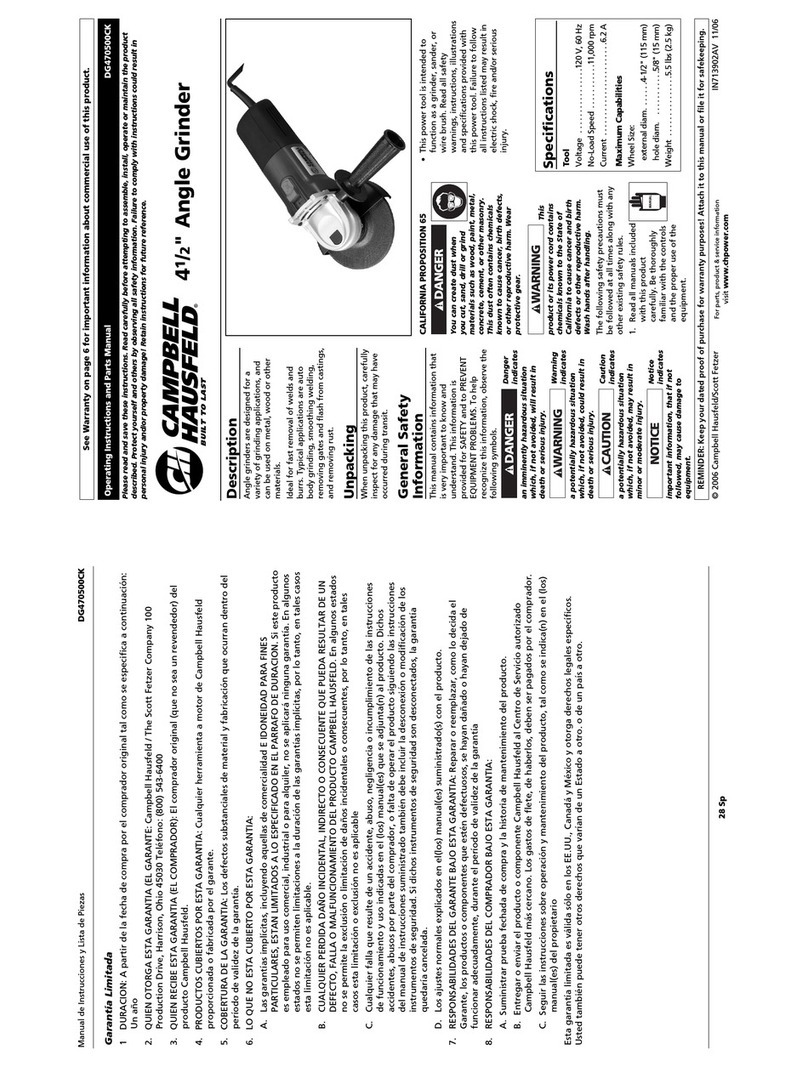
Campbell Hausfeld
Campbell Hausfeld DG470500CK Operating instructions and parts manual
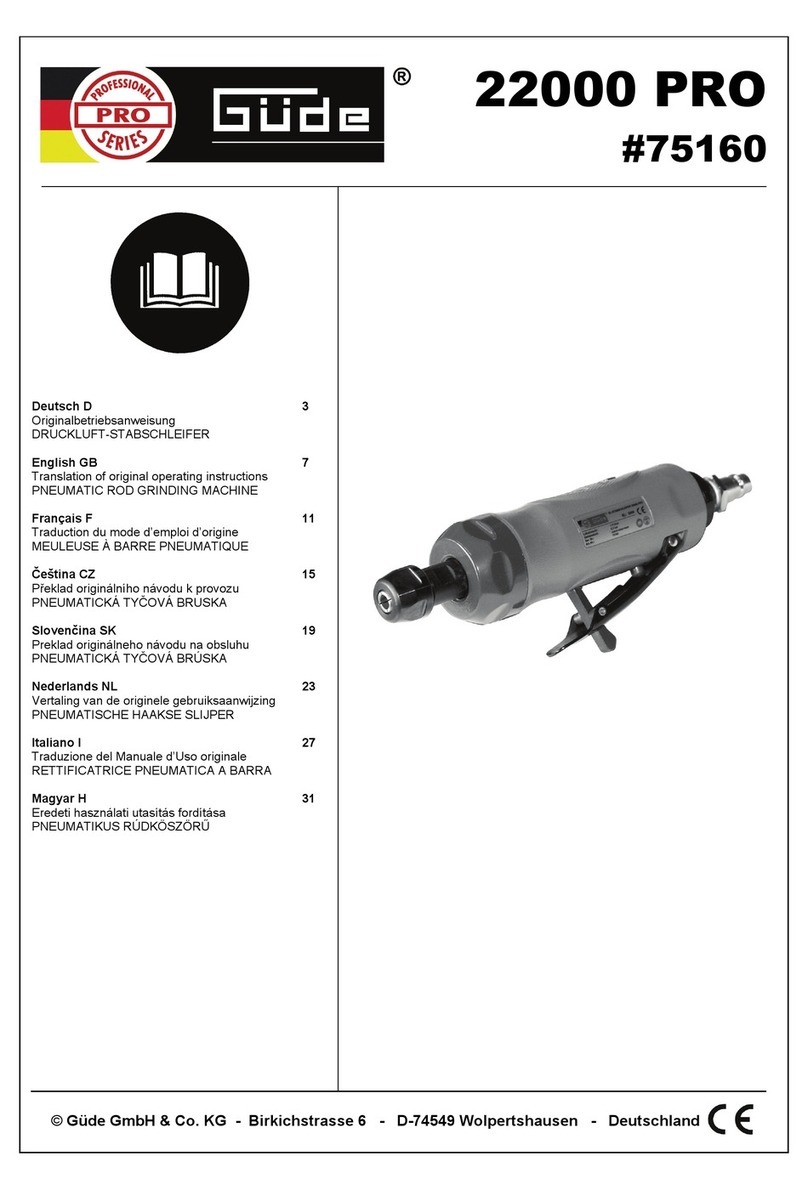
Gude
Gude 22000 PRO Translation of original operating instructions
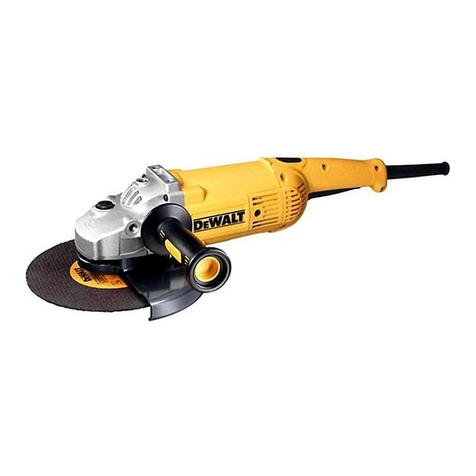
DeWalt
DeWalt D28415 Original instructions
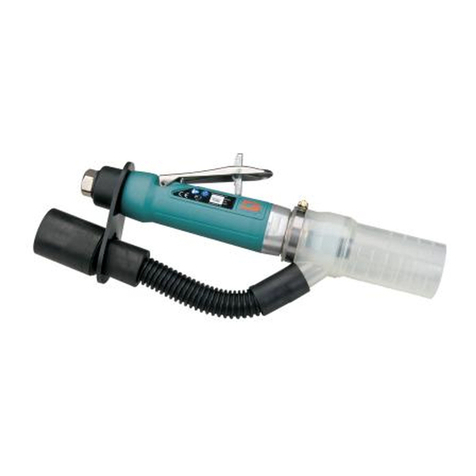
Dynabrade
Dynabrade 56743 Safety, operation and maintenance manual
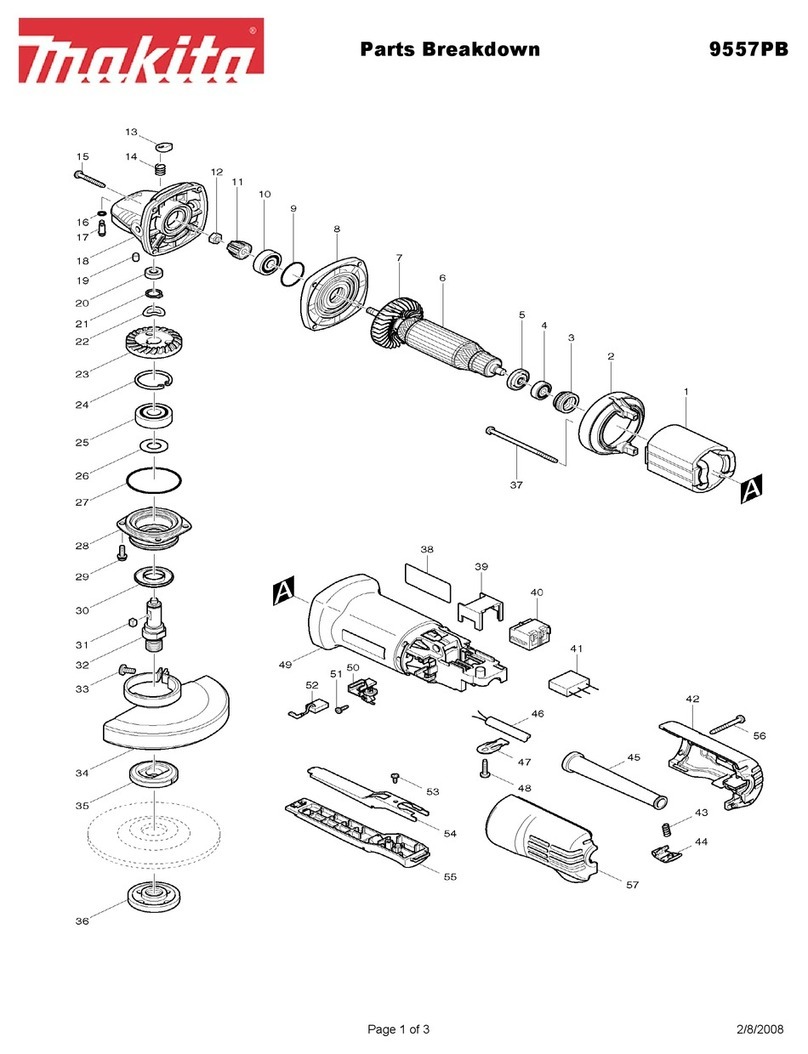
Makita
Makita 9557PB Parts Breakdown
